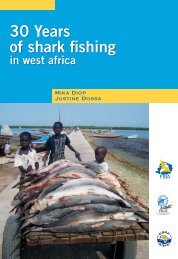Kyne & Simpfendorfer.. - Shark Specialist Group
Kyne & Simpfendorfer.. - Shark Specialist Group
Kyne & Simpfendorfer.. - Shark Specialist Group
Create successful ePaper yourself
Turn your PDF publications into a flip-book with our unique Google optimized e-Paper software.
efore relying on ovulated ova) and placental viviparity (a placental attachment is formed<br />
between the embryo and the maternal uterus).<br />
For viviparous species, uterine litter sizes provided throughout this Section are based on<br />
counts of ova (ovulated oocytes) or developing embryos in the uteri. Where uterine litter sizes<br />
are not available, ovarian fecundities, based on counts of the number of developing or<br />
developed follicles (oocyte surrounded by granulosa cells), may be provided. However, these<br />
estimates may not reflect actual uterine fecundity and hence an accurate measure of<br />
reproductive output if all oocytes are not ovulated and fertilized. Therefore, ovarian fecundity<br />
can provide a proxy for reproductive output but will generally always be higher than uterine<br />
fecundity for viviparous species. For example, Irvine (2004) noted that mean litter size was 3-<br />
4 less than mean ovarian fecundity in Etmopterus baxteri, with atretic follicles observed in<br />
some early pregnancies. Yano (1995) found a similar disparity between uterine and ovarian<br />
fecundity in Centroscyllium fabricii. Fecundity is more difficult to determine in oviparous<br />
species and again, ovarian fecundity can provide a proxy. Continuous sampling can reveal the<br />
length of any egg-laying period, although most deepwater oviparous species appear to deposit<br />
egg cases throughout the year. Egg-laying rates can generally only be determined from fish<br />
held in aquaria and these may not translate to actual rates in the wild as temperature is a<br />
contributing factor (Holden et al. 1971). Furthermore, the success of incubation and natural<br />
mortality will influence the actual number of offspring entering the population.<br />
In order to determine the annual fecundity (and indeed the lifetime fecundity) of a species, its<br />
reproductive periodicity needs to be elucidated. Many coastal and shelf species display<br />
seasonal reproductive cycles and with sampling of a population throughout the year, the<br />
seasonal pattern of follicle development, copulation, ovulation, gestation and parturition can<br />
be determined. This allows the length of the reproductive cycle (follicle development,<br />
ovulation, gestation and parturition) to be resolved and the reproductive periodicity can be<br />
determined as biannual, annual, biennial or perhaps longer. However, the majority of<br />
deepwater species exhibit an aseasonal reproductive cycle, with asynchronicity within the<br />
population. This makes a determination of the gestation period difficult and thus reproductive<br />
periodicity for most species remains unknown, although follicle and embryo development<br />
rates and sizes indicate a long cycle. Aseasonality in the reproductive biology of deepwater<br />
species may be related to the relative stability of their environment (Wetherbee 1996). For<br />
many deepwater squaloid sharks there is a resting period between parturition and the next<br />
ovulation, extending the reproductive cycle (Irvine 2004, Irvine et al. 2006b). Where litter<br />
sizes are known, together with age at maturity and longevity, one can calculate possible<br />
lifetime fecundities based on the number of reproductive years and assuming different<br />
reproductive periodicities (i.e. biennial or triennial) (Irvine 2004).<br />
The sexual maturity of chondrichthyans is determined by the anatomical, morphological or<br />
histological examination of external (male) and internal (male and female) reproductive<br />
characters. Where the size at 50% maturity (L 50 ; the size at which 50% of the population is<br />
mature) is available this is presented. Maturity is also expressed as a % of the maximum size<br />
(L max ) reached for the species (by sex – most chondrichthyans are sexually dimorphic with<br />
females growing to larger sizes than males, although the scyliorhinid catsharks tend to deviate<br />
from this trend). Maximum sizes given in the particular study are used for these calculations<br />
and not maximums recorded in the literature to avoid differences between populations,<br />
geographical locations or the effects of fishing. Holden (1974) observed that mean size at<br />
maturity occurs in female elasmobranchs at an average of 77% of asymptotic size (range 60-<br />
90%). From a more comprehensive review of 164 species of sharks, Cortés (2000) determined<br />
that sexual maturity occurs at about 75% of L max in both sexes. The deepwater species<br />
examined here are generally in agreement with these figures, although there are some<br />
exceptions.<br />
64
















